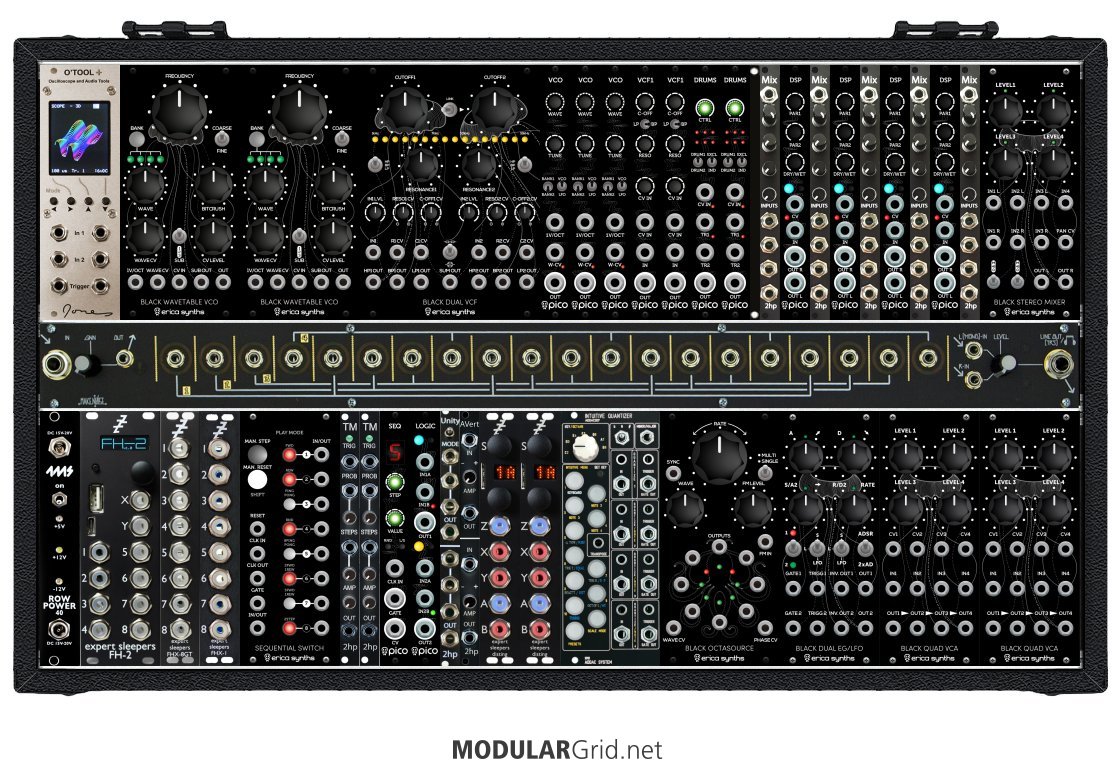Hi Ronin,
I appreciate the comments.
Replies are in-betweened below:
Seems you really like Erica Synth products.
I think that's mostly a result of my research starting with the Erica Synth line of products, so I'm fairly familiar with the product line's functionality. Im also trying to limit the build to a single MakeNoise 7U case w/ CV bus, so the small PICO line of modules are both helpful and problematic with their odd 3HP configuration ( work well in pairs )
All of your oscillators are digital. Is there a reason?
No - Not specifically, mostly I was looking for voice flexibility. I do have 2 analog poly-synths in the studio, but ideally this EuroRack build should be able to run as a portable stand alone system.
It feels that you wanted to go for as many panels in black as possible with the O'Tool being a necessity.
I admit to a certain degree, I was trying to maintain a consistent aesthetic with the rig, but that might not be feasible ultimately.
You're depending heavily on the FH2 for sequencing. Working on modular and go back and forth to a DAW isn't very ergonomic.
I was hoping the FH2 would serve several functions:
Clock source, including clock divisions for triggering percussion elements.
Euclidian rhythm generation
EGs
LFOs
and yes - I was relying on the FH-2's ability to generate LFOs in abundance to save rack space.
My thought was to use the ES Octasource and Dual EG/LFO as interactive EG and LFO sources ( I certainly could easily be underestimating how many EGs & LFO need to be easily accessible )
Have you used a DAW as a sequencer for Eurorack before?
No, I haven't - I'm completely new to Eurorack.
I see one EG/LFO unit. You're loaded up on oscillators, filters, and multi-effects units but really light on EGs. The FH2 can >output envelopes and LFOs as well... but they are really clunky to use in real time.
That's good to know - As I stated above, I was hoping to use the FH-2 for EG's & LFOs that would largely remain unattended once set up.
There's an additional PICO sequencer. Can it be sync'ed to the FH2 or another external clock? I'm not familiar with it.
Yes, the PICO SEQ is a 16 step sequencer that can accept an EXT Clock source.
It can store 16 sequences in memory
It can also generate random sequences internally, but unfortunately it can not be triggered to switch sequences. Changing sequences require human intervention. My thought was to use it as a source for logic operation combined with the Tuning Machines output for sequence evolution.
I would ease into Eurorack rather than buying a ton of modules and filling a case. Maybe this is your current "ideal" but that's >going to change quite a bit once you actually start using the modules.
Copy that - I wouldn't call this build ideal. It's just the result of my research and my current understanding of how these components interact, and my design goals- all of which will change as I learn more about the components.
But I am trying to take advantage of modulargrid and preview the rig as a complete system. ( before spending any money )
Don't depend on the FH2 to get you what you want. I bought one and it's a bit of a pain to use if you're trying to reconfigure it >while connected to a DAW. You have to use a webpage app and send updates via system exclusive to the FH2. If your DAW is >open you can't use the web app to update it at the same time.
Okay- got it. Communication with the FH-2 is thru Midi - SysEx. either your linked to the DAW or the control interface - yeah that could get annoying.
Thanks again for the feedback.
Cheers,
-m


